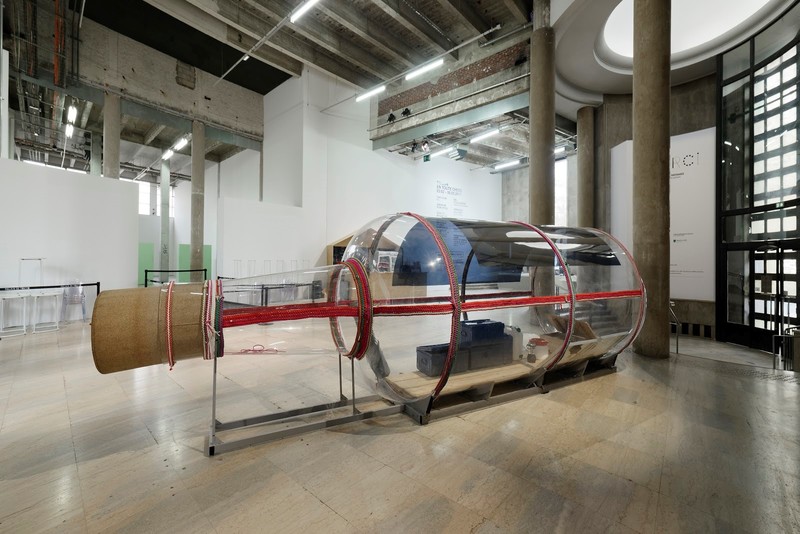Abraham Poincheval at the Palais de Tokyo, Paris
On Monday at midday, the Palais de Tokyo is already bustling with movement as visitors fill in the vast repurposed 1930s building. Their first encounter in the vast entrance is a giant glass bottle, large enough for a few people to comfortably remove the giant cork and slide inside. In fact, the inside of the bottle is fitted with a bed, a solar lamp and a few amenities, as though enticing us on to take that journey. This “message in a bottle” is not just an imagined situation: even though Bottle (2015) remains empty now, the artist Abraham Poincheval conceived of, then resided in the bottle, floating down the Rhône river in the South of France and camping on the riverbank along the way until he reached the glacier the river takes its source from in Camargue. The French artist defines himself first and foremost as a traveller: whether the journey is literal or internal, his artworks grant an opportunity for a unique experience. Walking through the Palais de Tokyo to the different artworks disseminated around the space allows for breathing space, taking the time to contemplate his work as separate interventions.
 Abraham Poincheval, Bottle, 2015. Installation view, Palais de Tokyo. Courtesy the artist and Galerie Semiose. Photo: Aurélien Mole.
Abraham Poincheval, Bottle, 2015. Installation view, Palais de Tokyo. Courtesy the artist and Galerie Semiose. Photo: Aurélien Mole.
Seeking out his works in the space, and taking time to consider them as a whole, seems to fit Poincheval’s work perfectly. His motive as a performance artist is to understand and experience the passage of time by residing in or journeying with the structures he has designed. This is how, for instance, the visitor ends up face to face with none other than a stuffed grizzly bear with a tiny lodging space carved out in its side. For Bear (2014), Poincheval was sealed inside the animal with enough food and water for thirteen days; a video on the wall facing the animal-house bears witness to these cramped “living” conditions which were, for him, necessary to experience time differently, “absorbing the space”. Just as impressive is Stone (2017), a huge rock split in half with a seated silhouette – that of the artist who spent a week sealed in the object within the Palais de Tokyo, starting at the opening of the exhibition. The rock has a momentous, powerful and almost spiritual presence, which is slightly undermined by the video record of Poincheval’s experience within the rock, which was streamed live during the performance itself. What is interesting in these experiments within a museum space is not the “proof” of the artist’s commitment but the reactions of visitors outside: a record of their interactions would have been insightful to capture the mood in the exhibition at that moment.
 Abraham Poincheval, Stone, 2017. Installation view, Palais de Tokyo. Courtesy the artist and Galerie Semiose. Photo: Aurélien Mole.
Abraham Poincheval, Stone, 2017. Installation view, Palais de Tokyo. Courtesy the artist and Galerie Semiose. Photo: Aurélien Mole.
During the 7-day performance as visitors came and went, people were shocked and intrigued but on a deeper level. They sought to reach out to the artist: someone shouted through the rock to speak with him and it was reported a young musician came to play the guitar to keep him company. A performance piece creates repercussions that depend on visitors’ interpretations and interactions. In this case, this experiment in time also led to a wider dialogue about taking the time to connect and the way in which we may isolate each other “socially” as individuals – not literally walled off in a 2-tonne stone, but hidden behind smartphone screens. Poincheval’s next performance, planned at the Palais de Tokyo for the 29th of March, might provoke a very different set of reactions: he intends to lay on chicken’s eggs within the space, until they hatch. This performance has the intention to explore the boundaries between human and animal. Like his entire body of work, it journeys into compelling and unexplored territory, provoking shock, confusion and empathy in its wake.
Abraham Poincheval is at the Palais de Tokyo, Paris, until the 8th of May.
http://www.palaisdetokyo.com/en/event/abraham-poincheval2
Claire, artvisor
Claire holds a degree in art history from Oxford University and master’s degree in Curating from the Courtauld Institute of Art. She is a French and British national and has worked in museums and art institutions in both countries.
